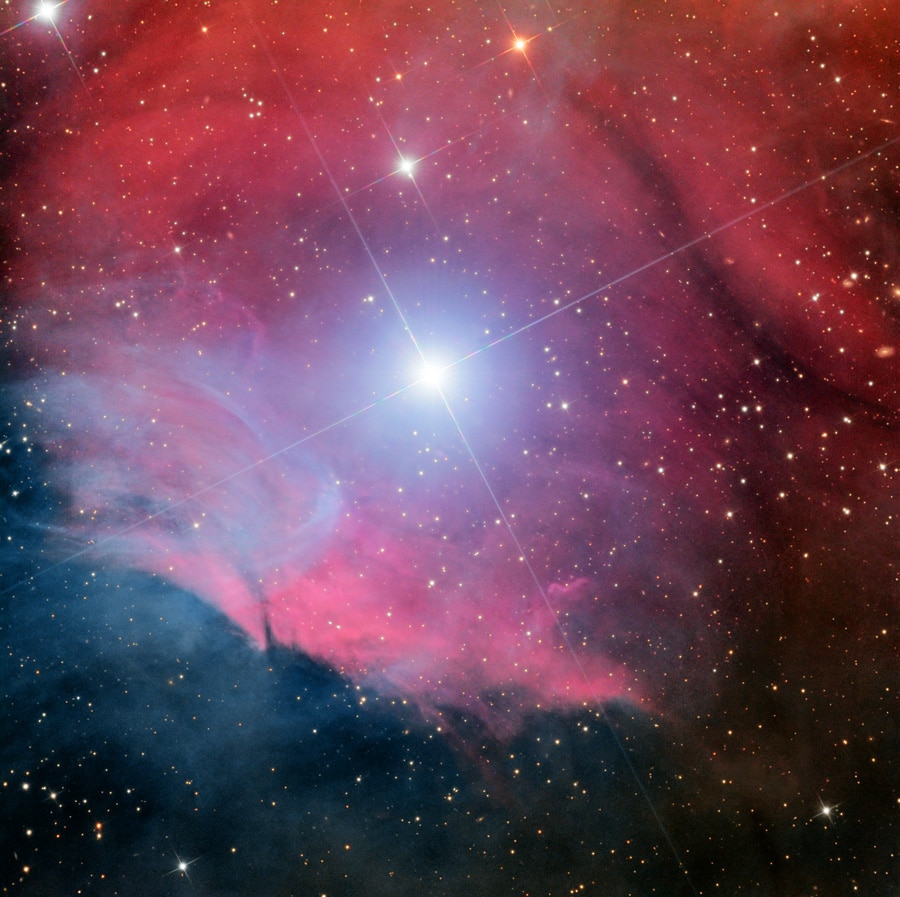Create a free profile to get unlimited access to exclusive videos, sweepstakes, and more!
Reflection and Emission

Near the top of the constellation Orion lies a star that you might easily pass over scanning the heavens. It’s just barely visible to the naked eye on a dark night, another white spark among thousands.
But this star, called HD 34989 (among other alphanumeric designations) is special. For one thing, it’s massive, probably 10 times the mass of our Sun. It’s also incredibly luminous, shining 15,000 times brighter than the Sun. Put that in the center of our solar system, and the global warming we’re experiencing now would seem like the deep freeze. Happily, it’s over a thousand light years away.
But in that location, it sits in the middle of a fairly large cloud of gas and dust, too. Because the star is so bright, it profoundly affects that nebula, as you can see for yourself in this exquisite photograph by Adam Block:
Adam took this picture with the 0.8 meter (32 inch) Schulman Telescope (RCOS) on Mt. Lemmon in Arizona. HD 34989 is pretty obvious; it’s the intensely bright star in the middle. The gas and dust are obvious, too…but what’s the deal with those colors? Why is some of the gas red, and some blue?
I’m glad you asked. Let us reflect on this question.
There are two ways for an object to be visible. One is if it reflects light from a nearby source (which is how we see the vast majority of objects around us), and the other is if it is intrinsically giving off, or emitting, light.
The star HD 34989 is emitting light, and that light is very blue. In fact, it gives off a lot of ultraviolet light. The gas cloud has a lot of hydrogen in it, which loves to absorb that UV light. When an atom of hydrogen gets zapped with UV, the electron gets blown off the atom. But then the remaining atom (really just a proton) has a positive charge, and attracts any electron around it. If one meets up with it, they combine once again to form a neutral atom. Due to complicated quantum mechanic effects, the electron jumps down a series of discrete energy levels, a bit like a ball rolling down a staircase. Every time it does that, it gives off a little bit of light.
As it happens, one of those energy level jumps is very popular among the excited hydrogen atoms. When an electron makes that drop, it emits a photon (a particle of light) in the red part of the spectrum. This emission is called hydrogen-alpha, or H-alpha for short (or even Hα if you want to get all fancy and Greek). It’s very common in warm gas clouds where some bright star is nearby.
So in this case the gas is energized by the star, and responds by emitting that glorious red color. There is a special Hα filter astronomers use to specifically observe that light, which Adam used in this picture to enhance the glowing hydrogen. In this case, the cloud is called an emission nebula.
So where does the blue come from then? That one’s easier. It’s just the blue light of the star reflected! In this case, the culprit isn’t gas, it’s dust—thick clumps of complex molecules created when stars are born, and when they die. It’s strewn throughout the galaxy, especially where you see big gas clouds.
That dust acts a bit like a mirror. When the light from the star hits it, that light gets scattered every which way, and some of it heads toward us. The star is blue, so it makes the dust look blue. That’s called a reflection nebula.
Many times where you see a blue reflection nebula you also see red emission gas as well. Not always, but that’s clearly the case here; in fact they have two different names: vdB38 for the reflection nebula and Sharpless 2-236 for the emission nebula. On Flickr I found a nice set of images showing how the reflected and emitted light can be combined to make a single image like Adam’s. You can see why astronomers use these filters; it helps distinguish what’s physically happening in the nebula.
Interestingly, not all the dust in that cloud is scattering the star’s light. See that sharp ridge of red at the bottom left of the nebula, right where we start to see blue light? That’s probably the edge of a large, dense cloud of dust called a molecular cloud (those are common in that part of space). The edge of it is being lit by the star, making it look brighter. This is very similar to what lights up the Orion Nebula and other famous (and gorgeous) objects.
It’s hard to believe all that is lit by a single star, but it is. Mind you, that whole glowing gas cloud is something like five light year across—50 trillion kilometers (30 trillion miles)! But HD 34989 is a monster. Only one star in a thousand is as massive, hot, and bright as it is. Which is something you should be thankful for; you don’t want to be too close to something like that…especially since, in a few million years or so, it’ll explode as a supernova. For something like that, it’s always best to be sitting at a safe distance. A thousand light years will do me just fine.



























